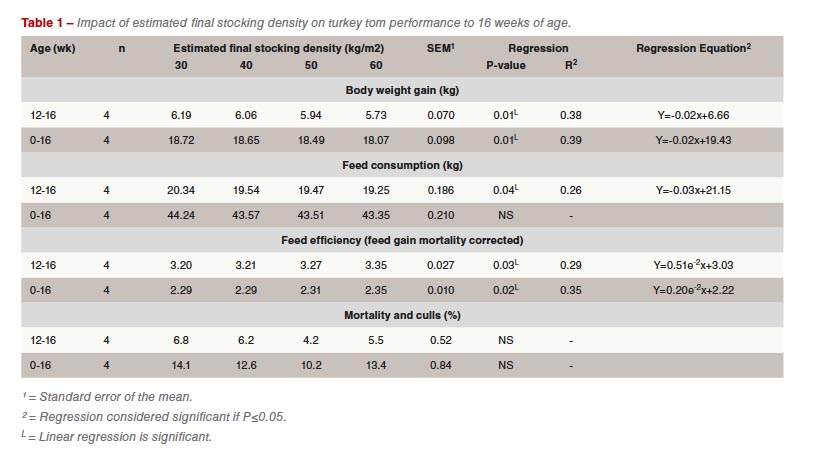
Stocking density can be one of the most important drivers of economic return; however it can greatly influence bird performance, health, and welfare. In regards to heavy turkey toms, there are few recent studies that take a comprehensive approach to stocking density.
Introduction
Increasing stocking density can negatively impact the environment (air quality and litter quality) which may in turn affect bird health. As a result, it is important to mitigate the effect of density on environment in attempt to remove any confounding factors. Past studies have reported negative effects of increasing stocking density on turkey tom performance, including body weight, feed consumption, and feed efficiency. Although less frequently evaluated, increasing stocking density has also been associated with poor gait scores, increases in footpad lesions and behavioural differences.
The aim of this study was to provide current, comprehensive data outlining the effects of graded levels of stocking density on turkey tom performance, health, and well-being.
Materials and methods
The experiment took place in two trials consisting of 1,434 Nicholas Select turkey toms. Each trial consisted of 2 room replicates of stocking density treatments (30, 40, 50, and 60 kg/m2) resulting in a total of 4 replicates per treatment. Birds were housed in large open rooms (6.71m x
10.06m) that were equipped with individual environmental controls. Air quality was monitored to assist in managing the ventilation to ensure consistent air quality across treatments. Body weight and feed intake were recorded at 4, 8, 12, and 16 weeks of age. Mortality was recorded daily and flock uniformity was assessed at week 12 and 16. Health and welfare parameters were assessed at 12 and 16 weeks of age and included footpad lesion scoring, gait scoring, feather condition and cleanliness scoring, heterophil to lymphocyte ratio (H/L ratio), incidence of aggressive damage, and behaviour.

Results and discussion
The results presented in these proceedings are for week 16 only. Bird performance (Table 1) was negatively impacted by increasing stocking density. Overall body weight gain from 0-16 weeks decreased linearly as stocking density increased (P=0.01). This decrease in body weight has been observed in previous studies with increasing stocking density. Feed consumption and feed efficiency were both negatively impacted by increasing stocking density within the last 4 weeks, however only feed efficiency was negatively impacted over the course of the entire trial (0-16 wks). Feed efficiency is not consistently affected by increasing stocking density, with certain studies showing no differences and other studies indicating significant decreases in feed efficiency. Total mortality (Table 1) and flock uniformity (not shown) was unaffected by increasing stocking density. While mortality was not significantly different in this study, two other studies have noted numerically high mortality in relation to high stocking density.

When evaluating health parameters, we observed an increase in footpad lesion score severity (P=0.02, linear) and in gait score (P=0.04, linear), as an indicator of lameness, as stocking density increased (Figure 1). Footpad lesions and gait score have not been evaluated frequently in relation to increasing stocking density; however some authors also observed a higher incidence of footpad lesions and poorer gait as stocking density increased in both hens and toms. In addition, both feather cover (P=0.01, linear) and feather cleanliness (P<0.01, linear) were poorer as stocking density increased at 16 weeks of age. The H/L ratio was not impacted by increasing stocking density at older ages (12 and 16 weeks).

Turkey tom behaviour (Figure 2) was impacted by increasing density, with resting (P<0.01, quadratic), standing (P=0.01, quadratic), walking (P=0.02, quadratic), preening (P=0.02, linear), and aggressive pecking (P=0.04, linear) differing by treatment. Birds housed at low stocking densities were more active and were seen resting less, however they also showed an increase in aggressive behaviours. Birds at moderate densities (40 and 50 kg/m2) were less active, less aggressive, and were observed more frequently resting and preening.
In conclusion, high stocking density, while economically beneficial, decreases bird performance and may pose a risk to bird health and welfare.

















